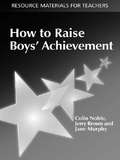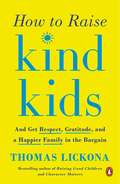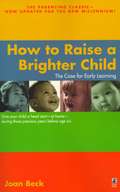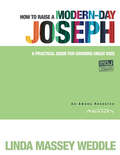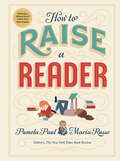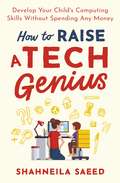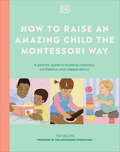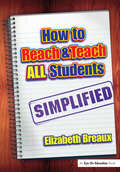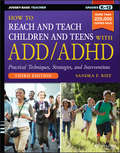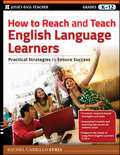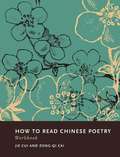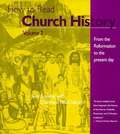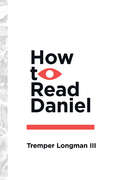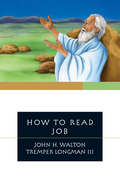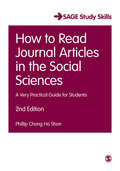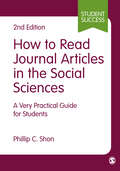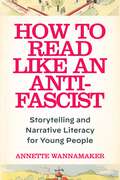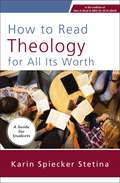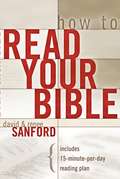- Table View
- List View
How to Raise Boys' Achievement
by Colin Noble Jerry Brown Jane MurphyThis book gives practical help to anybody who wishes to learn anything about the practical and accessible ways to raise boys' achievement in primary and secondary schools. Its down-to-earth language, easy style and rational sequencing of actions will appeal to all readers. This is essentially a handbook that can be used for reference, background reading, planning, preparing arguments, essays or as a general introduction to one of the most pressing issues in education today. The authoritative case studies and clear explanations of what to do and how to do it will be a boon to all readers. It discusses why some boys underachieve, what can be done to raise achievement, and how current national strategies aim to address the problem. It is aimed at headteachers, heads of department, ITT students, governors and parents in all phases of education.
How to Raise Kind Kids: And Get Respect, Gratitude, and a Happier Family in the Bargain
by Thomas LickonaCan you teach a child to be kind? This vital question is taking on a new urgency as our culture grows ever more abrasive and divided. We all want our kids to be kind. But that is not the same as knowing what to do when you catch your son being unkind. A world-renowned developmental psychologist, Dr. Thomas Lickona has led the character education movement in schools for forty years. Now he shares with parents the vital tools they need to bring peace and foster cooperation at home. Kindness doesn’t stand on its own. It needs a supporting cast of other essential virtues—like courage, self-control, respect, and gratitude. With concrete examples drawn from the many families Dr. Lickona has worked with over the years and clear tips you can act on tonight, How to Raise Kind Kids will help you give and get respect, hold family meetings to tackle persistent problems, discipline in a way that builds character, and improve the dynamic of your relationship with your children while putting them on the path to a happier and more fulfilling life.
How to Raise Successful People: Simple Lessons for Radical Results
by Esther WojcickiThe Godmother of Silicon Valley, legendary teacher, and mother of a Super Family shares her tried-and-tested methods for raising happy, healthy, successful children using Trust, Respect, Independence, Collaboration, and Kindness: TRICK. Esther Wojcicki—“Woj” to her many friends and admirers—is famous for three things: teaching a high school class that has changed the lives of thousands of kids, inspiring Silicon Valley legends like Steve Jobs, and raising three daughters who have each become famously successful. What do these three accomplishments have in common? They’re the result of TRICK, Woj’s secret to raising successful people: Trust, Respect, Independence, Collaboration, and Kindness. Simple lessons, but the results are radical. Wojcicki’s methods are the opposite of helicopter parenting. As we face an epidemic of parental anxiety, Woj is here to say: relax. Talk to infants as if they are adults. Allow teenagers to pick projects that relate to the real world and their own passions, and let them figure out how to complete them. Above all, let your child lead. How to Raise Successful People offers essential lessons for raising, educating, and managing people to their highest potential. Change your parenting, change the world.
How to Raise a Brighter Child
by Joan BeckTHE LATEST STUDIES PROVE SOONER IS SMARTER How much is a child capable of learning before the age of six? What happens to a child's brain during the preschool years when the body is growing so rapidly? How can working parents make sure their children are getting enough mental stimulation? Should parents help a youngster learn to read before he or she starts the first grade? How can parents safely use computers and the Internet as early learning tools? Is a child's intelligence level actually fixed for life by inherited genes? You'll find the answers to these and hundreds of other vital questions in this revised and updated edition of this classic parenting guide. How to Raise a Brighter Child incorporates groundbreaking scientific findings on brain development to help you boost your child's potential from birth. Discover specific early learning techniques to aid your child's development of his or her mind -- in his or her own personal style and at the appropriate speed. These are not formal lessons. Most are fascinating games. And they work!
How to Raise a Modern-Day Joseph
by Linda Massey WeddleAs parents, we strive to help our kids grow into their full potential. We help them with their homework, get them involved in planned activities, and invest for their college education.But while we may plan for their success, we can overlook a vital part of their personal development: Nurturing and encouraging a solid foundation of faith.It can be easy to assume our children are growing spiritually in church youth groups and programs. Yet it's vital that we take an active role in guiding them in their relationship with Jesus.The life of Joseph offers parents a Biblical standard for building children of character. Drawing from his story, this book will help you do just that. Inside you'll find a unique guide for creating a personalized plan for your child's spiritual growth, from preschool through high school. This practical guide will help your child: Acquire wisdom from the Bible Understand God's grace Gain a sense of destiny and purpose Develop a life-perspective based on God's perfect planThe result: Children and teenagers who know, love, and serve the Lord.So invest in their spiritual development. And create a legacy of faith that will last a lifetime.
How to Raise a Reader
by Pamela Paul Maria RussoAn indispensable guide to welcoming children—from babies to teens—to a lifelong love of reading, written by Pamela Paul and Maria Russo, editors of The New York Times Book Review. Do you remember your first visit to where the wild things are? How about curling up for hours on end to discover the secret of the Sorcerer’s Stone? Combining clear, practical advice with inspiration, wisdom, tips, and curated reading lists, How to Raise a Reader shows you how to instill the joy and time-stopping pleasure of reading. Divided into four sections, from baby through teen, and each illustrated by a different artist, this book offers something useful on every page, whether it’s how to develop rituals around reading or build a family library, or ways to engage a reluctant reader. A fifth section, “More Books to Love: By Theme and Reading Level,” is chockful of expert recommendations. Throughout, the authors debunk common myths, assuage parental fears, and deliver invaluable lessons in a positive and easy-to-act-on way.
How to Raise a Tech Genius: Develop Your Child's Computing Skills Without Spending Any Money
by Shahneila SaeedTeach computing concepts without computers! How to Raise a Tech Genius makes the computing curriculum accessible for parents and families.We live in a digital world - one in which our children are surrounded by technology. It's a part of their lives in a way that even the most tech-savvy adults aren't fully able to comprehend. What we do know is that the workplace of tomorrow will require our children to harness the power behind the technology, to be able to understand key concepts and apply them. Logical reasoning, creativity and problem solving are skills that are becoming increasingly essential in the world of work. How can we best prepare our children to enter this world? How to Raise a Tech Genius is a practical book that assumes no prior knowledge or understanding of computing and enables parents to learn skills and concepts alongside their children. The quick, easy and fun fifteen-minute activities within the book have been developed using first-hand teaching expertise and are fully mapped to the computing curriculum taught in schools. From a deck of playing cards to the story books on your bookshelf or even the contents of your fridge, How to Raise a Tech Genius uses everyday objects that can be found around your home to illustrate core computer science concepts. Children and adults alike will enjoying playing games while developing their algorithmic thinking and logical reasoning skills. This book demystifies the computing curriculum for adults, showing parents a whole new side of computing, coding and technology so that they can help their child become a computing genius!
How to Raise a Tech Genius: Develop Your Child's Computing Skills Without Spending Any Money
by Shahneila SaeedTeach computing concepts without computers! How to Raise a Tech Genius makes the computing curriculum accessible for parents and families.We live in a digital world - one in which our children are surrounded by technology. It's a part of their lives in a way that even the most tech-savvy adults aren't fully able to comprehend. What we do know is that the workplace of tomorrow will require our children to harness the power behind the technology, to be able to understand key concepts and apply them. Logical reasoning, creativity and problem solving are skills that are becoming increasingly essential in the world of work. How can we best prepare our children to enter this world? How to Raise a Tech Genius is a practical book that assumes no prior knowledge or understanding of computing and enables parents to learn skills and concepts alongside their children. The quick, easy and fun fifteen-minute activities within the book have been developed using first-hand teaching expertise and are fully mapped to the computing curriculum taught in schools. From a deck of playing cards to the story books on your bookshelf or even the contents of your fridge, How to Raise a Tech Genius uses everyday objects that can be found around your home to illustrate core computer science concepts. Children and adults alike will enjoying playing games while developing their algorithmic thinking and logical reasoning skills. This book demystifies the computing curriculum for adults, showing parents a whole new side of computing, coding and technology so that they can help their child become a computing genius!
How to Raise an Amazing Child the Montessori Way: A Parent's Guide to Building Creativity, Confidence, and Independence
by DKAn international bestseller, How to Raise an Amazing Child the Montessori Way adapts Montessori teachings for easy use at home. Packed with Montessori-based preschool activities and educational games that build confidence and independence through active learning, this authoritative illustrated guide helps raise self-reliant and creative children. Celebrate physical and intellectual milestones from birth to age six with activity checklists, and encourage development through proven child-centered teaching methods. This edition has been updated to include the latest child development research, advice about screen time in the digital age and a contemporary approach to cultural education. How to Raise an Amazing Child the Montessori Way shows parents how to bring the teachings of Montessori into their home to create a safe, nurturing environment for their children with clear and concise instruction.
How to Reach and Teach All Students—Simplified
by Elizabeth BreauxHaving worked with "at-risk" students for over 20 years, author Liz Breaux knows "we cannot teach our students until we reach them." This book demonstrates how –- by providing typical situations, along with "What Works", followed by "What Doesn't Work".
How to Reach and Teach Children and Teens with ADD/ADHD
by Sandra F. RiefThe most up-to-date and comprehensive vital resource for educators seeking ADD/ADHD-supportive methods How to Reach and Teach Children and Teens with ADD/ADHD, Third Edition is an essential guide for school personnel. Approximately 10 percent of school-aged children have ADD/ADHD--that is at least two students in every classroom. Without support and appropriate intervention, many of these students will suffer academically and socially, leaving them at risk for a variety of negative outcomes. This book serves as a comprehensive guide to understand and manage ADHD: utilizing educational methods, techniques, and accommodations to help children and teens sidestep their weaknesses and showcase their numerous strengths. This new 2016 edition has been completely updated with the latest information about ADHD, research-validated treatments, educational laws, executive function, and subject-specific strategies. It also includes powerful case studies, intervention plans, valuable resources, and a variety of management tools to improve the academic and behavioral performance of students from kindergarten through high-school. From learning and behavioral techniques to whole group and individualized interventions, this indispensable guide is a must-have resource for every classroom--providing expert tips and strategies on reaching kids with ADHD, getting through, and bringing out their best. Prevent behavioral problems in the classroom and other school settings Increase students' on-task behavior, work production, and academic performance Effectively manage challenging behaviors related to ADHD Improve executive function-related skills (organization, memory, time management) Apply specific research-based supports and interventions to enable school success Communicate and collaborate effectively with parents, physicians, and agencies
How to Reach and Teach Children and Teens with ADD/ADHD
by Sandra F. RiefThe most up-to-date and comprehensive vital resource for educators seeking ADD/ADHD-supportive methods How to Reach and Teach Children and Teens with ADD/ADHD, Third Edition is an essential guide for school personnel. Approximately 10 percent of school-aged children have ADD/ADHD—that is at least two students in every classroom. Without support and appropriate intervention, many of these students will suffer academically and socially, leaving them at risk for a variety of negative outcomes. This book serves as a comprehensive guide to understand and manage ADHD: utilizing educational methods, techniques, and accommodations to help children and teens sidestep their weaknesses and showcase their numerous strengths. This new 2016 edition has been completely updated with the latest information about ADHD, research-validated treatments, educational laws, executive function, and subject-specific strategies. It also includes powerful case studies, intervention plans, valuable resources, and a variety of management tools to improve the academic and behavioral performance of students from kindergarten through high-school. From learning and behavioral techniques to whole group and individualized interventions, this indispensable guide is a must-have resource for every classroom—providing expert tips and strategies on reaching kids with ADHD, getting through, and bringing out their best. Prevent behavioral problems in the classroom and other school settings Increase students' on-task behavior, work production, and academic performance Effectively manage challenging behaviors related to ADHD Improve executive function-related skills (organization, memory, time management) Apply specific research-based supports and interventions to enable school success Communicate and collaborate effectively with parents, physicians, and agencies
How to Reach and Teach Children with Challenging Behavior (K-8)
by Kaye Otten Jodie TuttleInterventions for students who exhibit challenging behaviorWritten by behavior specialists Kaye Otten and Jodie Tuttle--who together have 40 years of experience working with students with challenging behavior in classroom settings--this book offers educators a practical approach to managing problem behavior in schools. It is filled with down-to-earth advice, ready-to-use forms, troubleshooting tips, recommended resources, and teacher-tested strategies. Using this book, teachers are better able to intervene proactively, efficiently, and effectively with students exhibiting behavior problems. The book includes research-backed support for educators and offers:Instructions for creating and implementing an effective class-wide behavior management programGuidelines for developing engaging lessons and activities that teach and support positive behaviorAdvice for assisting students with the self-regulation and management their behavior and emotions
How to Reach and Teach English Language Learners
by Rachel Carrillo SyrjaPractical, ready-to-use ELL strategies firmly rooted in the latest researchThis book provides practical strategies and tools for assessing and teaching even the most hard to reach English language learners across the content areas. Syrja offers educators the latest information on working with ELLs (including using formative assessments) and provides a wealth of classroom-tested models and measures. These tools have proven to be effective with ESL students at all levels, including Long Term English Learners (LTELs). Throughout the book, the author shares powerful research-based strategies and clearly illustrates how they should be implemented in the classroom for maximum impact.Filled with proven ideas and easy-to-implement tips for teaching ELLsDesigned to be a practical ELL/ESL resource for classroom teachersSyrja, a former teacher and ESL student, is a noted expert in English language learning and a Professional Development Associate with the Leadership and Learning CenterThis value-packed guide offers educators accessible and research-based classroom strategies for reaching and teaching ELLs.
How to Read Chinese Poetry Workbook
by Cai Zong-Qi Jie CuiDesigned to work with the acclaimed course text How to Read Chinese Poetry: A Guided Anthology, the How to Read Chinese Poetry Workbook introduces classical Chinese to advanced beginners and learners at higher levels, teaching them how to appreciate Chinese poetry in its original form. Also a remarkable stand-alone resource, the volume illuminates China's major poetic genres and themes through one hundred well-known, easy-to-recite works. Each of the volume's twenty units contains four to six classical poems in Chinese, English, and tone-marked pinyin romanization, with comprehensive vocabulary notes and prose poem translations in modern Chinese. Subsequent comprehension questions and comments focus on the artistic aspects of the poems, while exercises test readers' grasp of both classical and modern Chinese words, phrases, and syntax. An extensive glossary cross-references classical and modern Chinese usage, characters and compounds, and multiple character meanings, and online sound recordings are provided for each poem and its prose translation free of charge. A list of literary issues addressed throughout completes the volume, along with phonetic transcriptions for entering-tone characters, which appear in Tang and Song-regulated shi poems and lyric songs.
How to Read Church History Volume 2: From the Reformation to the present day
by Jean Comby Diarmaid MccullochSpecifically geared to the adult learner; adaptable to individual, parish, and other group needs; and richly illustrated with photos and charts, this two volume set helps teachers and students connect the content of each text with their own life experiences and the community in which they live.
How to Read Daniel (How To Read Series)
by Tremper Longman IIIBeyond the familiar lions' den and fiery furnace, much of the book of Daniel seems baffling to modern readers.How to Read Daniel
How to Read Job (How to Read Series)
by John H. Walton Tremper Longman IIIPreaching's 2017 Survey of Bibles and Bible Reference
How to Read Journal Articles in the Social Sciences
by Phillip Chong Ho Shon'Shon's writing is engaging and entertaining; he opens up the "black box" of academic reading and writing, explaining how to decode and critique formal scientific writing and systematically organize information gained from reading journal articles' - Dr Lorraine Whitmarsh, School of Psychology, University of Cardiff, UK 'Once the reader has mastered Philip Shon's codes and applied them to texts, it will become increasingly impossible not to write and critique with integrity. I thoroughly recommend this book' - Professor Helen Cowie, Faculty of Health and Medical Sciences, University of Surrey, UK Many texts provide tips for successfully writing theses, dissertations, and journal articles. All argue that writing is like any other skill - it has to be developed, taught, and practiced daily. The same is certainly true of academic reading, yet many advanced students have trouble with the essential skill of 'reading critically'. This handy guide teaches you how to read so you're able to maximize your output in the writing process, whether you're a student or early career researcher. The author's unique reading code teaches you how to approach social and behavioural science journal articles as texts that can be deciphered structurally, mechanically and grammatically. The strategies included allow you to systematize the reading, note-taking and organizing of voluminous amounts of information in an easily identifiable and retrievable format, which will be a huge confidence boost to anyone who struggles with this first phase in the writing process. This book is indispensable for social and behavioural science students and researchers worldwide wanting to sharpen their critical evaluative skills for better academic writing. Phillip C. Shon is an Associate Professor of Criminology at the University of Ontario Institute of Technology. SAGE Study Skills are essential study guides for students of all levels. From how to write great essays and succeeding at university, to writing your undergraduate dissertation and doing postgraduate research, SAGE Study Skills help you get the best from your time at university.
How to Read Journal Articles in the Social Sciences: A Very Practical Guide for Students (SAGE Study Skills Series)
by Dr Phillip C. ShonThis superb guide teaches you how to read critically. Its no-nonsense, practical approach uses a specially developed reading code to help you read articles for your research project; this simple code enables you to decipher journal articles structurally, mechanically and grammatically. Refreshingly free of jargon and written with you in mind, it’s packed full of interdisciplinary advice that helps you to decode and critique academic writing. The author’s fuss free approach will improve your performance, boost your confidence and help you to: Read and better understand content Take relevant effective notes Manage large amounts of information in an easily identifiable and retrievable format Write persuasively using formal academic language and style. New to this edition: Additional examples across a range of subjects, including education, health and sociology as well as criminology Refined terminology for students in the UK, as well as around the world More examples dealing specifically with journal articles. Clear, focused and practical this handy guide is a great resource for helping you sharpen your use of journal articles and improve your academic writing skills. ‘I have used the book over the last five years with my students with great success. The book has helped students to develop their critical thinking, reading and writing skills and when it comes to writing a dissertation they have used the code sheet in their own writing.’ - Pete Allison, Head of the Graduate School of Education, University of Edinburgh SAGE Study Skills are essential study guides for students of all levels. From how to write great essays and succeeding at university, to writing your undergraduate dissertation and doing postgraduate research, SAGE Study Skills help you get the best from your time at university. Visit the SAGE Study Skills hub for tips, resources and videos on study success!
How to Read Journal Articles in the Social Sciences: A Very Practical Guide for Students (SAGE Study Skills Series)
by Phillip Chong Ho ShonThis superb guide teaches you how to read critically. Its no-nonsense, practical approach uses a specially developed reading code to help you read articles for your research project; this simple code enables you to decipher journal articles structurally, mechanically and grammatically. Refreshingly free of jargon and written with you in mind, it's packed full of interdisciplinary advice that helps you to decode and critique academic writing. The author's fuss free approach will improve your performance, boost your confidence and help you to: Read and better understand content Take relevant effective notes Manage large amounts of information in an easily identifiable and retrievable format Write persuasively using formal academic language and style. New to this edition: Additional examples across a range of subjects, including education, health and sociology as well as criminology Refined terminology for students in the UK, as well as around the world More examples dealing specifically with journal articles. Clear, focused and practical this handy guide is a great resource for helping you sharpen your use of journal articles and improve your academic writing skills. 'I have used the book over the last five years with my students with great success. The book has helped students to develop their critical thinking, reading and writing skills and when it comes to writing a dissertation they have used the code sheet in their own writing.' - Pete Allison, Head of the Graduate School of Education, University of Edinburgh SAGE Study Skills are essential study guides for students of all levels. From how to write great essays and succeeding at university, to writing your undergraduate dissertation and doing postgraduate research, SAGE Study Skills help you get the best from your time at university. Visit the SAGE Study Skills website for tips, quizzes and videos on study success!
How to Read Like an Anti-Fascist: Storytelling and Narrative Literacy for Young People
by Annette WannamakerOn the urgent need to promote critical reading skills amidst rising authoritarianismChildren’s author Philip Pullman famously said that “There are some themes, some subjects, too large for adult fiction; they can only be dealt with adequately in a children’s book.” While the recent rise of fascist ideology in the United States might seem a subject too large and adult to be dealt with in literature for children or teens, Annette Wannamaker proposes in How to Read Like an Anti-Fascist that there are books aimed at future generations which critique and counter fascist propaganda and mythmaking.Works of literature can reflect fascist ideology and promote it as well, but Wannamaker proposes that some books also offer tools for understanding it. Books written for beginners can introduce readers to complex concepts, break big ideas into manageable parts, and teach readers how to read the world outside of the book. Antifascist books are ones that analyze fascistic rhetoric and storytelling, educate about America’s long history of authoritarianism, and highlight various facets of fascism such as scapegoating others and reasserting patriarchal power.From “The Emperor’s New Clothes” and the tales of Superman to Mildred Taylor’s Roll of Thunder, Hear My Cry, the 1619 Project and contemporary works such as All Boys Aren’t Blue and Donald Builds the Wall, Wannamaker shows how the ethos of authoritarianism is characterized by a strict hierarchy that places children at its very bottom. In doing so, she argues convincingly that books written for young people can provide a particular view from the bottom, a perspective well-suited to interrogating systems of power.
How to Read Theology for All Its Worth: A Guide for Students
by Karin Spiecker StetinaThe Guide You Need to Read Theology Well.Too many Christians avoid reading theology for fear they won't understand it or out of a misconception that it's only meant for the academic elite. Similarly, students in introductory theology classes can feel overwhelmed by the concepts and terminology they encounter.Yet theology can be read with enjoyment and discernment. In How to Read Theology for All Its Worth, professor, author, and devoted reader Karin Stetina introduces students to the basic skills of intelligent reading, applied especially to theological works. Anyone who'd like to read theology well, whether a formal student or interested layperson, will benefit from the simple steps Stetina outlines.Steps include:Identifying genreBecoming acquainted with the author and the context out of which he or she wroteDetermining a thesis and main argumentsHow to Read Theology for All Its Worth will equip readers not only to understand theology but also to insightfully engage authors' ideas. With the basic tools in hand, everyone can read with confidence and enjoy "conversations" with theological works.
How to Read Your Bible
by David SanfordAs a dedicated Christian, you've decided to follow Jesus Christ and have accepted the challenge to read through the Bible. Up until now, your Bible reading has been pretty hit-and-miss. To be honest, so far you've only hit Genesis, the first half of Exodus, part of Psalms, and portions of the New Testament and missed the rest. The thought of reading from Genesis to Revelation is exciting-but slightly intimidating. You'd like some help! Where do you turn? This book will guide you on your journey through the Scriptures, both showing the way and answering common questions. For every Christian who wants to read or is trying to read through the whole Bible, here is the book that shows the way! After all, it takes more than good intentions and will power to get that needed epiphany that "I really can read through God's Word." How to Read Your Bible answers the following questions: Why Should I Read the Bible? Is My Bible Inspired? Is My Translation Trustworthy? What About Apparent Errors? Where Do I Start Reading the Bible? What Do I Look for When I'm Reading? How Do I Make Sense of What I'm Reading? How Do I Personalize What I'm Reading? What Do I Do After I Read?
How to Read a Book: Una Guía Clásica Para Mejorar La Lectura (A\touchstone Book Ser.)
by Charles Van Doren Mortimer J. AdlerWith half a million copies in print, How to Read a Book is the best and most successful guide to reading comprehension for the general reader, completely rewritten and updated with new material.Originally published in 1940, this book is a rare phenomenon, a living classic that introduces and elucidates the various levels of reading and how to achieve them--from elementary reading, through systematic skimming and inspectional reading, to speed reading. Readers will learn when and how to "judge a book by its cover," and also how to X-ray it, read critically, and extract the author's message from the text. Also included is instruction in the different techniques that work best for reading particular genres, such as practical books, imaginative literature, plays, poetry, history, science and mathematics, philosophy and social science works. Finally, the authors offer a recommended reading list and supply reading tests you can use measure your own progress in reading skills, comprehension, and speed.
